TABLE TENNIS IN CHINA
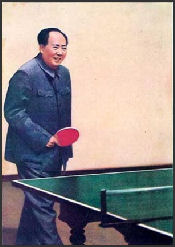
Table tennis, known as “ping pang qiu” in China, is a popular and revered game in China. For a long time it was really the only sport in China, sort of like football, basketball and baseball all rolled into one, except a hundred times more popular. One 30-year-old Chinese man told the New York Times, “I can remember when I was 3, we had a black-and-white TV, with three channels...And we had Ping-Pong.”
Table tennis is the most popular racket sport in world. It is the perfect sport for cramped China. A ping pong table is easy enough to make — if nothing else is available a piece of plywood or concrete slab with a row of bricks as a net will do as a table — and it doesn't take up much space. Nearly all schools, factories and office building have a few tables ensconced somewhere. Ping pong is sometimes played in rural areas with pieces of cardboard for paddles. The only piece of real equipment that is necessary is a ping pong ball. Ping pong is not a Chinese word. It is a term coined by the game company Parker Brothers, which owns the rights to the name.
Table tennis is a sport that anyone can play. It can be enjoyed by the elite and the poorest of the poor. All that is required to play it are a pair of paddles and ball and a table and net that can easily be improvised. Mao Zedong, Zhou Enlai and Deng Xiaoping all played. Tables can be found in train stations and next to offices and rural fields, with people playing the game when ever they take a break or need to kill some time.
Table tennis is a popular spectator sport. Over 300 million Chinese tuned in to watch the Olympics men’s singles gold medal match, featuring two Chinese players. One 68-year-old fan told the Washington Post, “I still like to watch the sports that the China is good at... China is good at small balls, like badminton ping pong and tennis, not big balls.”
Of late interest in table tennis is declining among young people, who have became more interested in sports like basketball and soccer as well distractions like movies, pop music, the Internet and video games. Data from the mid-2000s suggests that basketball and soccer were roughly tied as China’s most popular sport with table tennis in third. Table tennis now regarded by many an old people’s game. In some parks all the public ing pong tables are dominated by men and women in the 50s, 60s and even 70s who show up with a paddle and container with leaf-laden tea.One 60-year-old woman told the New York Times, “Older people still like Ping Pong. But the young people have a lot of choices. They have many chances to do other sports. When I was young, we only had Ping-Pong.”
See Separate Article PING PONG DIPLOMACY: THE PRELUDE TO NIXON’S VISIT TO CHINA factsanddetails.com ; SPORTS IN CHINA factsanddetails.com ; History of Table Tennis allabouttabletennis.com ; Secrets of Chinese Table Tennis masatenisi.org
Early History of Chinese Table Tennis
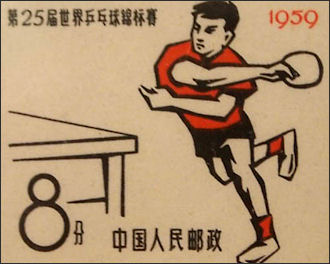
1959 ping pong stamp Table tennis originated as an English parlor game and was invented in Victorian Britain. London Mayor Boris Johnson said "pingpong's coming home" at the closing ceremony of the 2008 Beijing Games.The game was quite popular among New York intellectuals in the 1950s. Popular speakeasies featured it and beat poets, artists and novelists played it. The writer Henry Miller called it “a game of endless fascination.” In the 1960s it emerged as popular recreation game among American suburban kids. These days it is popular among London movers and shakers like rock musician Damon Albarn and art collector Charles Saatchi.
Ping pong was brought to Japan in 1902 by a university student who had learned to play in England. It eventually spread to China, where revolutionary leaders Mao Zedong and Zhou Enlai would often play against each other during their long years of political exile.
One key figure in popularizing ping pong in China was a British banker named Ivor Montagu, a devoted communist who codified the rules of Ping-Pong in the 1920s and created the International Table Tennis Federation. Steven V. Roberts wrote in the Washington Post, “He was “convinced that the sport could spread communism throughout the word,” because the toiling masses could play it during the workday. Griffin points out that the “balls were so light they flew best in windowless rooms,” making Ping-Pong a sport that could be played without ever leaving the factory. [Source: Steven V. Roberts, Washington Post, January 24, 2014. Steven V. Roberts teaches journalism and politics at George Washington University |=|]
“After the communists seized power in 1949, Montagu decided that table tennis could help reconnect China to the rest of the world. In 1951, 20 years before Beijing claimed China’s seat at the United Nations, Montagu invited the communist regime to join his international federation and enter the world championships. His strategy, Griffin writes, was that this simple and “faintly ridiculous” sport could provide a “human face to give Beijing the appearance of warmth no matter how cold or calculating the Chinese government intended to be.” After a Chinese player won the world championship in 1959, Mao congratulated him personally and called Ping-Pong China’s new “spiritual nuclear weapon.” |=|
Mao and Chinese Table Tennis
In the early 1950s, Mao decreed table tennis as the national sport of China. Sinologist saw the decree as a shrewd move by Mao to shore up his legitimacy by developing the sport and producing wold-class players as a way for China to build post-revolutionary self-confidence, show the world it can excel at something and get over the humiliations of the previous century and a half. [Source: Matthew Syed, The Times of London, August 10, 2008]
Why Mao chose to highlight table tennis is not known. Perhaps it is because he liked the game himself and realized it was the perfect low-cost game for a nation of peasants. In any case, China was admitted to the International Table Tennis federation in 1953 and it wasn’t long before world-class tennis players emerged.
In 1959, Chinese player Ring Guotuan won the table tennis world champions in 1959, becoming the first Chinese to be a world champion in any sport. Mao deemed the victory a “spiritual nuclear weapon.” He was succeeded by Zhuang Zedong, who won the next three world titles. Mao lavishly praised the player and made light of the fact they played in a Chinese way using the distinctive penholder grip.
To make sure that the successes continued coaches were sent around the country looking for young children with quick reflexes and excellent hand-eye coordination, pioneering a recruiting system that would later be applied to other sports. Table tennis like everything else suffered in the Cultural revolution. Hounded and tortured by Red Guards, three members of the national team committed suicide in 1968, including Rong Guotuan.
Steven V. Roberts wrote in the Washington Post, “Kids in China today don’t swat Ping-Pong balls — they shoot hoops. They don’t wear Red Guard scarves but Houston Rockets jerseys. They don’t glorify Mao Zedong the revolutionary but Yao Ming the basketball player. Table tennis is now a “living fossil,” a sport “your dad plays.” So who’s winning after all?” |=|
Zhuang Zedong
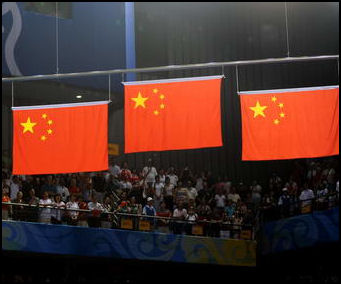
Chinese Olympic sweep
Zhuang Zedong is regarded by many as the best table tennis player ever. He was a three-time world champion, in 1961, 1963 and 1965. One man in 60s recently told the New York Times, “We were all quite fascinated by the champion Zhuang Zedong. I was in primary school, and we had a stone table. We all tried to get the table to play during our 10-minute recess.”
Zhuang was major player in the ping-pong diplomacy that brought the United States table tennis tam to China but also has been linked to some dark episodes in the Cultural Revolution. A devoted Maoist and ally of the Gang of Four, he was jailed along with other members of the Chinese table tennis team for allying themselves to Mao’s rival Liu Shaochi — ironic considering the fact that Zhuang once said, “I owe my entire table tennis success to the study of Ma Zedong philosophy.”
See Ping Pong Diplomacy
Zhuang’s role in the Ping Pong diplomacy rehabilitated him within the party. He headed the Chinese delegation when the Chinese table tennis team toured the United States and was appointed Minister of Physical Culture and Sports and made a member of the elite Central Committee of the Communist Party.
During the tour of the United States, Zhuang performed card tricks and offered bits of wisdom such as: “Though Ping-Pong is a highly competitive sport, the is no real victory or defeat. There is always both. Just as there is no life without death, There is no death without life. The whole world is unified like this.”
After Mao’s death and the collapse of the Gang of Four Zhuang was lost his government position and was forced to work as a street sweeper. He was publically denounced for among things “wearing a Swiss-made watch” and was sentenced to prison, where he spent four years in solitary confinement. At one point he tried to commit suicide by hanging himself with belt. After getting out of prison he has held low-level coaching jobs and only recently has been invited to minor sporting events.
Later History of Chinese Table Tennis
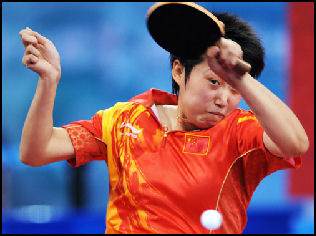
Guo Yue in 2008
Chinese table tennis was thrown into crisis in the 1989s when Sweden, a country with less than 1 percent of the population of China, emerged as a major table tennis power and outperformed China at key tournaments. Led by Jan-Ove Waldener, a blonde-haired innovator known for his balletic style, Sweden defeated China 5-0 at the world championships in 1989. The defeat triggered deep soul searching among the Chinese table tennis establishment and ideological stagnation was seen as the major culprit behind China’s decline.
Since the 1950s, table tennis was taught with a strong ideological bent. The coaching manual — formally approved by Mao himself — was seen as a source of universal truth not just playing technique. Questioning or making innovations that debunked the manual were seen as sacrilegious. Adherence to the conventional penholder grip was a major obstacle. For six years the Swedes ruled. Waldener became a major celebrity in China.
In the mid 1990s a new breed of flashier, more creative Chinese table tennis players began to emerge. Chief among those was Liu Guoliang. He developed a radical adaption to the penholder grip — the swivel-wristed backhand — which he used to put awesome spins on the ball and win world and Olympic titles in the 1990s. A large contingent of new players emerged. One of them, Kong Linghui, who used many techniques taken from Waldener, played Waldener at Sydney in 2000 in one of table tennis’s “classic matches” with Kong emerging as the winner.
Table tennis has become less popular as a participation sport as more and more other sports are finding followings and losing viewers as a spectator sport because the results are often obvious from the start. One 22-year-old man told the Washington Post, “Ping-pong became a popular national sport because of politics. But nowadays I think even pool is more popular than ping pong.”
Table Tennis Rules

women final in Beijing in 2008
Most everyone knows the basic rules of table tennis. Players hit a hollow celluloid ball with a rubber-covered paddle over a net on a table. If the ball goes off the table or falls into the net. The other player gets a point. Players serve the ball five times an then let the other player serve five times, with the ball hitting on the server’s side of the table before it goes over the net.
To make the game more spectator friendly the International Table Tennis Federation increased the size of regulation balls by two millimeters in 2000. It also prohibited players from hiding their serves with their hands or arms and made the games shorter — the first player to11 (not 21) wins with at least a 2 point lead — and made the matches longer (best four of seven rather than three of five).
At the Beijing Olympics in 2008, doubles table tennis was replaced by team table tennis, with each team consisting of three players. There is a world team tennis competition that is typically dominated by China.
The same ball is used throughout the match and players chase down errant shots, sometimes climbing over barriers to get the ball. The players wear the same baggy uniforms they have for years. The loose shirts are tucked into the elastic waistband of the pants which are so loose the are sometimes hitched up like diapers. There has been some discussion about introducing more stylish, even sexy, outfits like those worn by tennis players. Fashion shows have been held at major tournaments to display new designs.
Table Tennis Grips and Balls

Man Lin with a penholder grip
Table tennis has been described as “a game of chess, with the speed and agility of boxing. Chinese and Asians are known for using fancy spins and hitting the ball with pinpoint accuracy while Europeans are known for taking big swings and hitting the ball hard. Tall Chinese are particularly effective with their top spin shots.
There are two kinds of grips; the penholder group and the handshake grip similar to a tennis grip. The penholder is favored in Asia, It looks awkward, but is suited for moving easily between forehand and backhand and putting spins in a ball. A top class player can hit ball so it goes 80mph and makes 100 rotations per second, This means an opposing payer has only a half second to anticipate, react and make a shot.
On table tennis strategy an Olympics supplement in the New York Times read: “It’s all about spin — backspin, sidespin, corkscrew and topspin — and the best players keep opponents guessing with different combinations of shots every point. Though it’s not uncommon to see players standing as far as 20 feet behind the table, the smartest adhere to closer-lower-faster rule: the closer you are to the table, the lower you catch the ball off the bounce and the faster you hit it, the less time you’ll give your rival to respond to your shot.”
Chinese Table Tennis
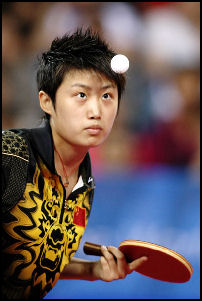
Guo Yue
No sport has been dominated quite the way that the table tennis has been dominated by the Chinese. Chinese have won 16 of gold medals since the sports was introduced as an Olympic sport in 1988 in Seoul. For the Chinese not to sweep any event is regarded as a major upset. The four highest ranking men and the five highest ranking women in world in table tennis at the time of 2008 Beijing Olympics were all Chinese.
China has so many good players that players who would have had a good shot at a gold medal or world title if they were on another country’s team don’t even make the Chinese team. If good players want to emigrate to other countries and become citizens the Chinese team doesn’t try to stop them and lets them go.
Chinese women have won 11 of the 12 women’s table tennis Olympics gold medals awarded since the sport was added to the Olympics in 1988. They have won 17 world singles titles since 1961, including 14 of the last 15. With the expectation of 1991, when a South Korean won, Chinese women have won every world championship since 1975. No non-Asian woman has won world championship or Olympics since 1955.
The Chinese men’s table tennis record has not been as so good as the women but still has been good. Chinese men have won 20 world titles since the 1970s, including five of the last six. Going into the Beijing Olympics in 2008 the men’s team won the last four world championships and won 7 of 10 Olympic gold medals. Some have called the men’s singles table tennis event the “Super Bowl” in China.
Some professional players play into their 40s and even 50s. Table tennis athletes from other countries feel they have to train and play in China if they want to be competitive. In their home countries there simply isn’t enough competition to challenge them. A U.S. coach told the Washington Post, American players “keep training in China because they realize these are [better options] than they have in the U.S...They understand they have to go to China and sacrifice and train all year long. Usually, if the athletes believe they don’t have a good chance, they won’t go to China.
In the past decade the Chinese men have won nearly every world and Olympics title. The only loss the mens singles title was at the world championships in 2003 and the only time a non-Chinese made it to finals in the men’s doubles was when Germany did it in 2005.
The Super League is the top professional ping pong league in China. The teams are based in cities and have Olympic champion players. Sometimes several thousand fans show up at the games.
There is ranking system for ping pong players like there is for tennis. Chinese coaches have traditionally tried to instill military style discipline in their players, even prohibiting them from dating team mates.
Chinese Table Tennis Training
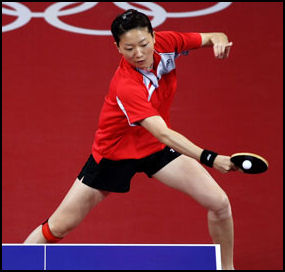
Li Jia Wei
Much of China's success is due to its systematic, Soviet-style approach of recruiting promising 5- or 6-year-olds to sports schools and then ruthlessly winnowing the field for the national team. Describing a table tennis training facility in China, Mark Viera wrote in the Washington Post, “Inside a massive buildings on a university campus, 20 Ping-Pong tales stretched across a hardwood floor. There are locker rooms, showers and a coach’s office, and guests have to remove their shoes, the great hall clicks and clacks — all day long and often until dark — with children, teenagers and adults who dedicate hours to training.”
The Luneng Table-Tennis School in Shandong has 230 boarding students and a gymnasium that holds 80 tables. During training sessions — which generally last for four hours in the morning and evening three times a week — nearly all of them are used by young player in identical red shirts and black shorts. Leung is regarded as one of the more academically-oriented sports schools. Students spend several hours in academic classes on weekday afternoons.
A 10-year-old girl at Luneng told Time, “China’s so god at ping pong because we train harder than anyone else. I always feel like I need to work harder because that is the only way I can become an Olympic champion.”
Chinese Table Tennis Players
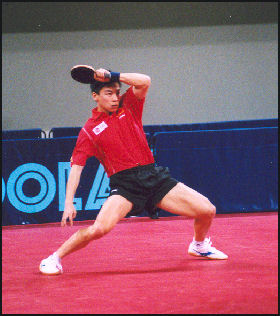
Chen Qi For foreigners, China's most famous athlete may be retired 7-foot-5 (2.26 meter) basketball star Yao Ming. For Chinese, it's probably 4-11 (1.5 meter) Deng Yaping, who won four Olympic pingpong gold medals in Barcelona in 1992 and Atlanta in 1996. Deng was named Chinese female athlete of the 20th century, earned a doctorate at Cambridge University and a sits on the People's Political Consultative Conference, a ceremonial body dominated by the Chinese Communist Party.
Before the Beijing Olympics in 2008, China boasted the four top men players (Wang Hao, Ma Lin, Ma Long and Wang Liqin) and the top five women players (Zhang Yining, Guo Yue, Li Liaoxia, Guo Yan and Wang Nan). Only three players made the men’s team and only three made the women’s team.
Wang Hao is regarded as a master of the radical penholder grip developed by Liu Guoliang and he uses it to deliver an affective reverse forehand. He won a silver in Athens in 2004, losing to Rye Seiung-min of South Korea. Later Wang admitted that he choked in losing to Rye. In Beijing his hair was tinted red. Ma Lin is another member of the Chinese table tennis team. He also uses the radical penholder grip and likes to fan himself between points.
Wang Liqin, a tall and popular veteran, is a three-time world champion. He emerged on the scene as a nerdy 15-year-old but know is regarded as something of sex symbol, and has been photographed bare-chested. His playing style is similar to that of the Swede Jan-Over Waldener.
Wang Nan is regarded as the most successful table tennis player ever. She has won four Olympics gold medals. Zhang Yining has also won four gold medals. Zhang keeps her face expressionless when she plays. She has short cropped hair and looks something like a tomboy but has posed for glamorous photo shoots. Wang wears a half smile and sticks out her tongue when she loses a point.
On the stress of trying to win the gold medal, Wang Nan, who won a gold in Athens in 2004, said, “In the end, there wasn’t much reason for me to smile because the pressure of being gold medalist is huge.”
Bad Boy Table Tennis Players
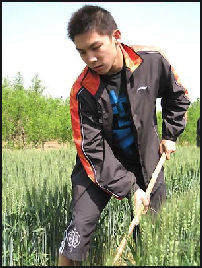
Chen Qi
Chinese ping pong players are big celebrities. They drive around in fancy cars and live flamboyant lifestyles described in detail in gossip magazine. When salaries, endorsements and club play are added together many earn more than $100,000 a year. One group of players on the national team made a hip hop video in which one player raps: “I hit a round of head-on smashes — three big shots: pow pow pow.” This is far cry from the Maoist era when top players earned $12 a month.
Some of Chinese ping pong players have a reputation for rowdiness . Kong Linghi, won the gold medal in the men’s singles at Sydney. in 2000, crashed his white Porsche Carrera into a taxi after a night of heavy drinking and playing mah jongg. He was able to escape doing jail time but was fined and forced to publically apologize for the incident. Kong is a notorious gambler who is rumored to have lost $20,000 on a single hand of blackjack.
Olympic table tennis doubles champion in 2004 Chen Qi lost his temper and kicked a chair into the air after losing in the men’s final at the Asian Cup in 2006, a match watched by millions on television in China. Afterwards he apologized on television, saying, “I lost the match and my sportsmanship...I created a terrible international impression.” But that wasn’t enough. His coaches sent him to a village, where he was forced to weed a cucumber patch while a crowd gathered around him and shouted advise, The move, which brought memories of the Cultural Revolution, was intended to instill in Chen “the quality of trial over adversity.”
Chen’s experience still fell far short of what people endured in the Cultural Revolution. He only had to stay in the village for a week rather than years as was the case in the Cultural Revolution. Chen was put up in an air-conditioned room, provided with good home-cooked meals, and treated like a celebrity in the village where he stayed.
Other well known table tennis players include Olympic champion Liu Guolinag and woman’s table tennis star Deng Yaping. He Zhili was one of the top women's table tennis players in China in the 1980s. After marrying a Japanese player she began playing for Japan under the name Chire Koyma. "The Chinese feel bitter toward me," she told Time on the eve of her appearance at the Olympics in Sydney in 2000.
Wang Ho was offered counseling in 2008 after the Olympics after an angry confrontation with a security guard at a karaoke club during which he reportedly shouted: “I am the famous Wang Hao! I am the world champion! Does it matter if I beat you?”
Chinese Ping Pong Player Wang Hao Gets Permission to Date Girlfriend
“In the summer of 2009, after years of punishing training and sacrifice, China's table tennis star Wang Hao has finally been rewarded — not just with the world No.1 spot, but with the right to have a girlfriend,” Tania Branigan wrote in The Guardian. “Sports officials have decreed the 25-year-old player can date a fellow athlete, local media have reported, five years after he fell foul of a ban on romance.[Source: Tania Branigan, The Guardian, September 1, 2009]
“We never forbid a player having a girlfriend as long as he meets the age requirement,” said the national table tennis team manager, Huang Biao. Wang, the men's singles world champion, started seeing another national teamplayer shortly before the Athens Olympics in 2004. But his 17-year-old girlfriend Fan Ying was promptly dismissed — one of four players axed for relationships with teammates that year. She has since been allowed to return. “As for the relationships between players, we do not advocate them but we do not oppose them either,” Huang told the Chengdu Business Daily. “It is normal to have a love affair at this age.” Wang's new girlfriend, Peng Luyang, is a former national champion. Table tennis officials, said to be among the most conservative in China's state sports system, may hope that she will prove a stabilizing influence on him.
In 2008, the China Daily said there was an “unwritten law” that table tennis players should not date each other. One top player, Wang Jin, told the newspaper that she left for a career in Japan after falling in love with her now husband, Liu Guoliang, then a star player and subsequently men's head coach. “It was made very clear that it was impossible to continue our relationship if we were on the same team,” she said.
Olympic Table Tennis
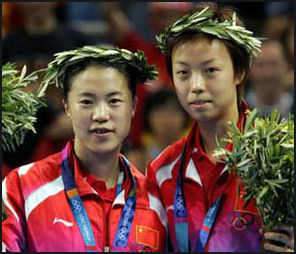
Wang Nan and Zhang Yining
At the 2004 Olympics in Athens China won six medals in table tennis. Wang Na and Zhang Yining won the gold medal in women’s doubles, beating Lee Eun Sil and Suk Eun Mi of South Korea, 11-9. 11-7, 11-6 and 11-6. Top-seeded favorites Guo Yue and Niu Jianfeng of China won the bronze. China’s Chen Qi and Ma Lin won the gold medal in men’s doubles, beating Lai Chak Ko and Ching Li of Hong Kong 11-6, 11-9. 7-11, 11-8. 8-11, 11-5.
At the 2000 Summer Olympics in Sydney China won all four gold medals and 8 of 12 total table tennis medals.
The finals of ping pong world championships usually feature top Chinese players playing one another. In 1996, half the top 12 men players were from China and eight of the top 12 women were from China and the remaining four — who played for Taiwan, Hong Kong, Canada and Japan — were all born and trained in mainland China.
Of the 61 players who entered in the 1996 Olympic women's singles event, 20 did most of their training in China even though they represented 12 different countries. Moreover, 11 of the 46 countries entered in the men's and woman’s ping pong events had Chinese coaches.
Table Tennis at the 2008 Beijing Olympics
The table tennis events at the Beijing Olympics were played at the new Peking University Gymnasium. Dubbed the world’s first arena built especially for table tennis, it looks like it is holding a giant ping pong ball from the outside. Inside the ventilation system directs air away from the playing area so as not to disturb the movement of the ball.
China won all the table tennis events, including the team gold medals, at 2008 Olympics in Beijing and took all six medals in the singles events, for a total of eight medals, its most ever. The Chinese table tennis coach Liu Guolinag said, “They played perfectly to create this perfect ending for the ping-pong competition at the Beijing Olympics. I never dreamed it would be so easy.” China had dominated table tennis since it was introduced as an Olympics sport in 1988 but had never won all the medals before and only swept one event, the women’s singles in Seoul in 1988.
The table tennis matches at the Beijing Olympics were held before rowdy audiences. The arena’s announcer exhorted fans to do the Mexican wave while “We Will Rock You” by Queen blared from the loudspeakers. Outside fans showed off their tickets and posed for pictures in front of the arena waving the Chinese flag. Chinese President Hu Jintao showed up to watch the Chinese women’s team win their gold medal.
Describing the crowd watching the men’s team final, John Branch wrote in the New York Times, “Cheering during a match comes in quick and tidy bursts. It is bad form to make noise during play and people shushed others for being impolite. Sometimes fans could not help themselves. Thrilling rallies were accompanied by a collective, “Ho...oh! Ho...oh!” It was the sound of people catching their breath when a return looked impossible, and exhaling when it safely hit the table...As the point finished, usually for the Chinese, they cheered a triumphant “Oh!” Some shook rattles that sounded liked mini-abacuses.
During breaks at the table tennis venue, Jingjing the panda mascot entertains the crowds by dancing, jumping and gyrating to the theme song from “Beverly Hills Cop”.
Table Tennis Events at the 2008 Beijing Olympics

Wang Hoa China swept the men’s singles. World No.2 Ma Lin beat world No.1 Wang Ho in the final 4-1 in a matches that featured a number of fast and furious rallies. Ma won the first two games 11-9, 11-9, lost the third 6-11 and won the last two 11-7, 11-9. Wang Liqon defeated Orgen Persson for the bronze. The bronze medal match was played first and the final was played with three red flags of China already prepared for the medal ceremony. Ma Lin was a four-time World Cup winner. The gold in Beijing was his first Olympic medal.
The Chinese table tennis teams roared through the tournament without losing a match The Chinese women easily beat Singapore 3-0 in the women’s team gold medal match. It was the first medal awarded in team table tennis, which replaced doubles. The men were tested more in their matches, They won the gold medal with a 3-0 victory over Germany but were given a run for their money against Australia in an early match. At one point Chinese player Wang Liquin lost the first game to Australian William Henzell and had to fight back from 10-10 tie in the second game with a return from 5 meter slam that had so much spin on it Henzell couldn’t handle it.
China swept the medals in women’s singles. Zhang Yining won the gold medal. The No. 1 women’s player in he world and a double gold medalist in Athens, she defeated compatriot Wang Nan, the silver medalist, 8-11, 13-11, 11-8, 11-8, 11-3 in a closely contested match. Lefty Guo Yue, the reigning world champion, won the bronze. The gold medal was Zhang’s forth in the Olympics. Wang has also won four gold medals.
The top American player at Beijing in 2008, Gao June, won a silver medal for China in Barcelona in 1992 before emigrating to the United States. The entire U.S. team was composed of Chinese-born players, Chinese-born players also played for Singapore, Brazil, Spain and other countries.
Making China's Table Tennis Olympic Team Tougher than Winning an Olympic Medal
In April 2012, AP reported: For Chinese competitors in table tennis, the toughest thing about this Olympic year almost certainly won't be the players from other countries. It'll be making the national team. China owns table tennis like the United States once dominated men's basketball. It has won every gold medal in three Olympics, and four years ago in Beijing it finished 1-2-3 in both men's and women's singles, and swept gold in both team events. [Source: AP, April 8, 2012]
Rules allow for only three men and three women on the team, a quandary since Chinese men and women hold the top five spots in the world rankings. The cutthroat selection process is sure to end with celebrated players left out, including three-time Olympic gold medalist Ma Lin.
"The Chinese teams do not have a weak link," said Adham Sharara, the Egypt-born president of the International Table Tennis Federation. "If you take away any of the team members, they remain very strong. As a matter of fact, they could even enter two teams and maybe win a gold and a silver medal."
Olympics Table Tennis Rule Changes That Prevent China from Sweeping the Olympic Medals
China's supremacy even prompted the ITTF to alter its rules for the London Games, hoping to give a few others a chance. This time around, only two players from one nation can enter singles, eliminating the possibility of another 1-2-3 finish for men and women. China will still be favored to slice and serve its way to gold and silver, and win both team gold medals. The third qualifier for Chinese men's and women's team will be limited to playing to playing the team event. "The (Olympic) tournament cannot be dominated as before by the Chinese," Sharara said, arguing that both quality and participation are in the Olympic spirit. "This way we have a chance to mix the two."
Chinese officials have been unhappy with the moves. "There might be a shortage of talent for other teams, but for us - we don't have enough spots," men's coach Liu Guoliang said in an interview recently with the newspaper Sports Fans. "The ITTF might be the one to blame since they have been constantly changing the rules."
China’s 19 years as the champs in world team table tennis came to an end in 2010 when Chinese women failed to win the gold medal in the event, falling to Singapore in the final in Moscow. The Chinese blamed the loss on the fact that two of the three members of the team had never played in such a high level competition before.
Image Sources: Beijing Organizing Committee for the Games of the XXIX Olympiad, Xinhua, Getty images, Time
Text Sources: New York Times, Washington Post, Los Angeles Times, Times of London, National Geographic, The New Yorker, Time, Newsweek, Reuters, AP, Lonely Planet Guides, Compton’s Encyclopedia and various books and other publications.
Last updated June 2015
